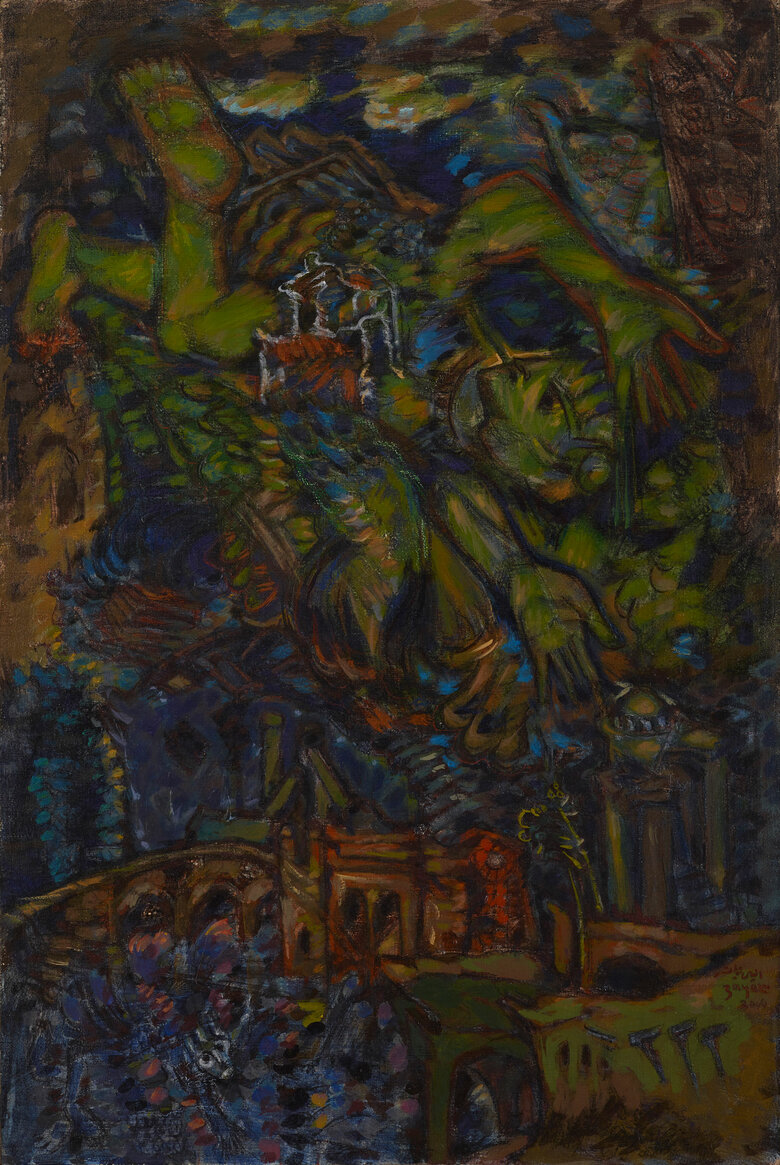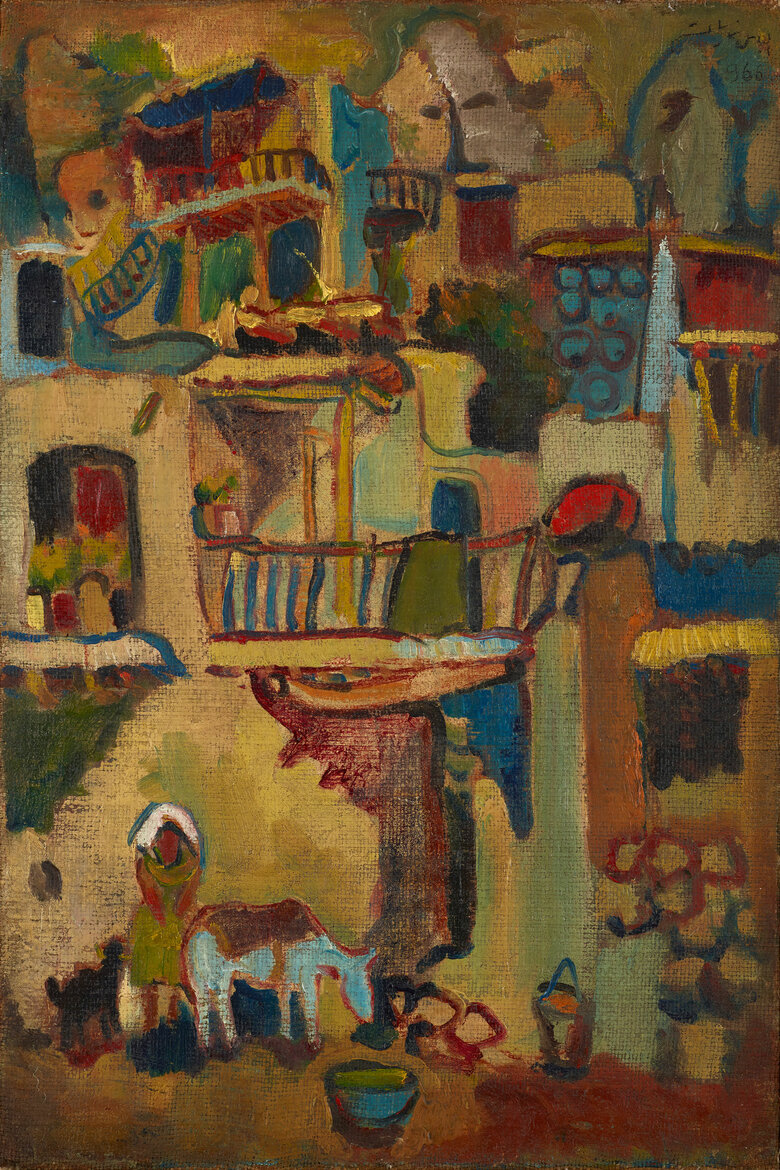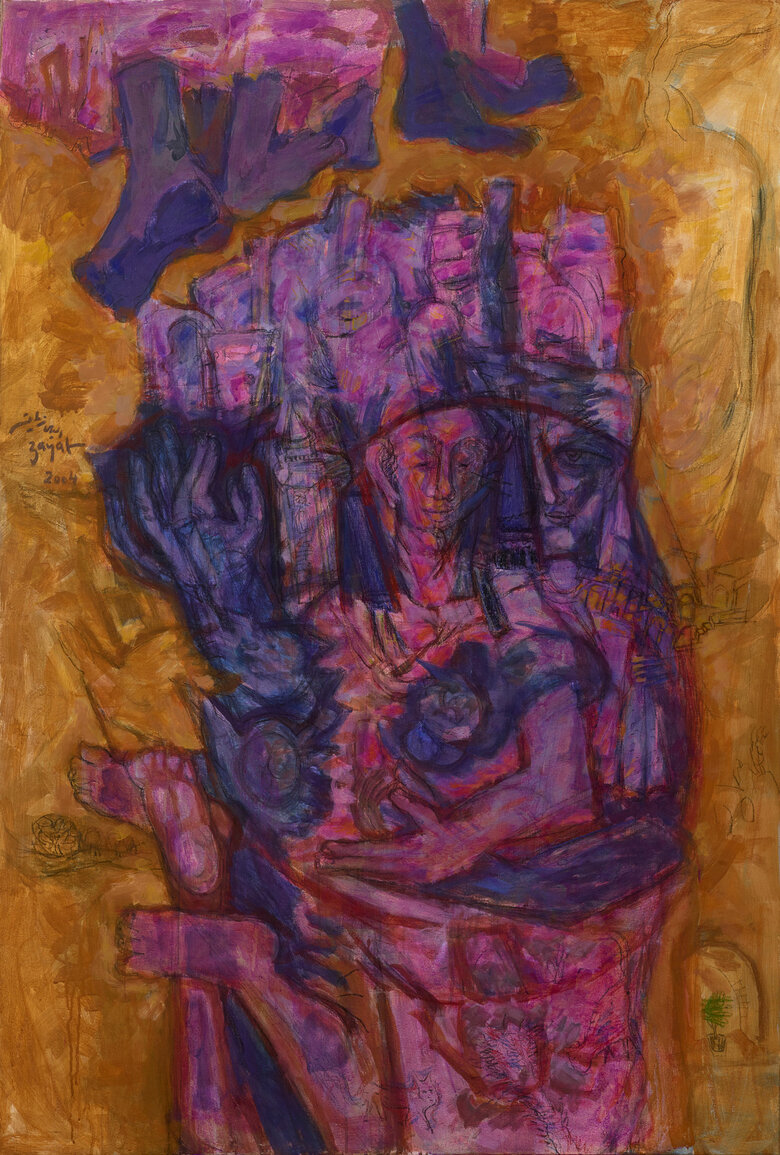Born in the old city of Damascus, Elias Zayat grew up in the Christian district of Bab Tuma. He was raised in an intellectual family, enjoying the pleasures of reading books, while listening to his...


ELIAS ZAYAT, Syria (1935 - 2022)
Bio
Written by ARTHUR DEBSI
Born in the old city of Damascus, Elias Zayat grew up in the Christian district of Bab Tuma. He was raised in an intellectual family, enjoying the pleasures of reading books, while listening to his mother playing piano at home. At an early age, Zayat showed his parents an interest in art, and caught the attention of his teachers in school, who noticed his skills to draw from life. When he turned 17 years old, Elias Zayat started training under the supervision of the Syrian painter Michel Kursheh (1900-1973), a prominent figure of the modern art movement in Syria.
When in school, Elias Zayat didn’t really pay attention to the course, and used to imagine a fantastic world, while contemplating the walls, and the roof of the classroom. Even though the teachers would reproach him for doing so, Zayat remembered: ‘These were the first images I would draw. My visual memory contributed to my process’[1].
After Syria received its independence from France in 1946, the artistic momentum accelerated, and the government progressively got more involved in the cultural activities. In 1950, the General-Directorate of Antiquities and Museums was founded, and sponsored the annual Syrian group exhibition of ‘hand painting’[2]. Eight years later, the General-Directorate of Antiquities and Museums became the Ministry of Culture and National Guidance, including a Directorate of Fine Arts, and a Department of Acquisitions and Exhibitions, within its structure. The government also started acquiring works from the National Museum of Damascus. On the other hand, the creation of the Syrian Society of Arts marked this decade, followed by the creations of artists’ associations.
Elias Zayat witnessed this dynamic period, especially when he went with Michel Kursheh (1900-1973) to the opening of the third annual Syrian exhibition in 1952. Yet, since the art was still not included in any higher education program, the government granted some students scholarships to study in Europe, as well as Egypt. Zayat benefited from a scholarship to go to Bulgaria, where he started studying at the National Academy of Art in Sofia in 1956. Under the supervision of the artists Boris Mitov (1891-1963), and Ilya Petrov (1903-1975), he practiced various genres such as portraits, still lives, and landscapes. In parallel, Elias Zayat was affiliated to a group of students, which encouraged the subjectivity in art, taking inspiration from the post-Impressionist artists[3]. Studying in Sofia also enabled Zayat to travel all around European countries, such as France, and Belgium, where he liked to visit galleries, and museums.
In 1960, Syria was part of the United Arab Republic, which was a political union with Egypt. The latter’s administration was responsible for the art education, and Syrian students had to complete their studies in Cairo[4]. Hardly returned from Bulgaria to his home country, Elias Zayat consequently traveled to Egypt, where he enrolled at the Faculty of Fine Arts of the University of Cairo, and trained under Abdul Aziz Darwish (1918-1981). He also received a bachelor degree in Fine Arts from Ain Shams University in Cairo. Back to Syria in 1961, the United Arab Republic dissolved, and Elias Zayat was appointed instructor at the College of Fine Arts at the Damascus University in 1963[5], when the Ba’ath party took power. In 1973, Zayat decided to go back again to Europe, where he studied restoration at the Academy of Fine Arts in Budapest, Hungary, for one year. Throughout his career, Elias Zayat highly dedicated himself to art education, holding many positions at the College of Fine Arts of the Damascus University. From 1962 to 1980, he was successively appointed assistant professor, and associate professor, prior to be full professor of art between 1980 and 2000.
The experience, that Elias Zayat acquired abroad, led him to experiment with different techniques, and find his own artistic style. In Europe, he focused on the work on colors, inspired by the post-Impressionist works of Paul Gauguin (1848-1903), and Henri Matisse (1869-1954). He also trained in the use of paintbrush, and learned how to manipulate pigments, and to analyze materials. However, it was in the Middle East, where Zayat found inspiration, through his several trips in Egypt, and Syria. In Cairo, he visited museum such as the Coptic Museum, and discovered the Ancient Egyptian art, the Fayoum portraits from the late 1st century B.C., as well as Islamic artworks from the Fatimid and Mamluk times. In the 1960s, Zayat travelled all around Syria, and visited its numerous archeological sites, including Horan, and Palmyra. He thus reconnected to the country’s cultural heritage, and conducted research on Ancient Syrian art. In the Dalloul Art Foundations’s collection, Ma’aloula (1966), is part of a series of paintings, where Elias Zayat depicted the famous Christian village of Ma’aloula, in northeast of Damascus. The city has always been familiar to the artist, since he used to go there on holiday during summer with his family[6]. In the work Ma’loula (1966), he illustrated, through a palette of warm colors, a daily life scene, where a woman is busy with some tasks, surrounded by animals, in the bottom left corner. Here, the technique demonstrates the shift towards abstract art in Zayat’s oeuvre in the 1960s. In 1965, he effectively co-founded with Mahmoud Hammad (1923-1988), and Nasser Chaura (1920-1992), the Damascus Group, also called ‘Group D’. Although the group didn’t last long, the members contributed to elaborate debates on plastic experimentation, especially on abstraction. In Ma’aoula (1966), the painter realized a two-dimensional representation, flattening the foreground, and superimposing the pictorial elements. These latter elements are reduced to simple, abstract forms, partly contoured with thick blue brushstrokes. Cities have always been a recurrent subject in the art of Elias Zayat, as he stated: ‘Most of humanity now lives in the city. They are born and die in the city, and thus the city is part of their being, and they are part of the city’[7].
Depicting the village of Ma’aloula reveals the attachment of Elias Zayat to the religious heritage of Syria. From a Christian family background, the artist conducted extensive research on Syriac iconography, while being in charge of the conservation of frescoes, and icons, present in churches such as Deir Mar Mikhael, in Lebanon, and Deir Mar Takla, in Syria, between 1970 to 2014. Thanks to these commissions, he was able to improve his technique on Christian artistic practice, that he then adapted in his paintings as of the mid-1970s. One of the sources, in which he was particularly interested, was the Syriac manuscripts, as he said: ‘In the 1980s, I saw the Syriac manuscripts at the Deir Mar Musa al-Habashi (the Monastery of Saint Moses the Abyssinian), the Rabbula Gospel Folio (sixth century CE). I immediately recognized the similarities between the figures in these miniatures and the Arab-Islamic miniature’[8]. Dated from 1985, and also part of the Dalloul Art Foundation’s collection, the work The Visit (Liqa’) reveals Elias Zayat’s deep knowledge on Syriac miniature. The artist painted the episode in the Gospel of Saint Luke (1:36), when Mary visited her cousin, Elizabeth, to announce her pregnancy. Zayat followed the iconographic tradition, placing the two characters at the entrance of a house, behind them. Mary is wearing a dark blue coat, while Elizabeth is covered by a red one. Occupying the middle of the composition, the two women embrace each other, and are surrounded by birds, and plants, which indicate the garden. In this artwork, Elias Zayat showed that he joined in the traditional art practice of the Church of the East, related to the use of images, from the beginning of Christianity[9]. However, the artist also integrated the aesthetics of Ancient Syrian art sculptures, that he had contemplated in the temples of Palmyra. As another source of inspiration, Zayat wrote: ‘I discovered the ancient art that pre-dated the Greek and Roman conquest of the region, (…) and then I saw Palmyra’s funerary reliefs from the second and third centuries [CE] and was convinced that the roots of Syrian Christian art also came from this region’[10]. In The Visit (Liqa’), Zayat reworked on this aesthetics, by purposely exaggerating the hands of the characters, and distorting the proportions of their bodies. Through its surrealistic aspect, the scene conveys a mystical dimension, on which Zayat would work through his research on the philosophy of Sufism.
The oeuvre of Elias Zayat reflects the rich artistic heritage, which have persisted for centuries in Syria. Detaching himself from post-Impressionism, Zayat worked on various styles, while delving into the history of his country. Referring to the aesthetics of Ancient Syrian art, Syrian Christian art, Sufism, and works from European masters; the painter found an experimentation terrain by combining them all. In the 20th century, this artistic approach, that Elias Zayat chose, became an important part of the modern art movement in Syria, celebrating its cultural, and religious mosaic.
Elias Zayat passed away in 2022.
Notes
[1] Elias Zayat in an interview with Salwa Mikdadi in Mikdadi, Salwa, and Donald Kunze. Elias Zayat: Cities and Legends. Milano, Italy: Skira, 2017. [P.244]
[2] Lenssen, Anneka. ‘The Shape of the Support: Painting and Politics in Syria's Twentieth Century’. Dissertation, Massachusetts Institute of Technology, 2014. [P.13]
[3] Mikdadi, Salwa, and Donald Kunze. Elias Zayat: Cities and Legends. Milano, Italy: Skira, 2017. [P.15]
[4] Mikdadi, Salwa, and Donald Kunze. Elias Zayat: Cities and Legends. Milano, Italy: Skira, 2017. [P.15]
[5] In collaboration with the Faculty of Fine Arts in Alexandria, the Higher Institute of Fine Arts in Damascus was founded in 1960, prior to become the College of Fine Arts, three years later.
[6] Elias Zayat in an interview with Salwa Mikdadi in Mikdadi, Salwa, and Donald Kunze. Elias Zayat: Cities and Legends. Milano, Italy: Skira, 2017. [P.243]
[7] Elias Zayat in an interview with Salwa Mikdadi in Mikdadi, Salwa, and Donald Kunze. Elias Zayat: Cities and Legends. Milano, Italy: Skira, 2017. [P.243]
[8] Elias Zayat in an interview in July, 8 2015.
[9] Chaillot, Christine. Rôle des Images et Vénération des Icônes dans les Églises Orthodoxes Orientales. Geneva, Switzerland: Dialogues Entre Orthodoxes, 1993. [P.16]
[10] Copy of a letter from Zayat to Khawla Qal’aji, dated 27 November 2006.
Sources
Ali, Wijdan. Modern Islamic Art: Development and Continuity. Gainesville, USA: University Press of Florida, 1997.
Atassi, Mouna, and Samir Sayegh. Contemporary Art in Syria, 1898-1998. Damascus, Syria: Gallery Atassi, 1998.
Chaillot, Christine. Rôle des Images et Vénération des Icônes dans les Églises Orthodoxes Orientales. Geneva, Switzerland: Dialogues Entre Orthodoxes, 1993.
Eigner, Saeb. Art of the Middle-East, Modern and Contemporary Art of the Arab World and Iran. London, UK: Merell Publishers Limited, 2011.
Hammad, Lubna. ‘A History of Art Associations in Damascus During the 20th Century: From Emergence Until the First Arab Conference of Fine Arts in Damascus in 1971.’ Translated by Basel Jbaily. Atassi Foundation. Accessed December 16, 2020. https://www.atassifoundation.com/features/a-history-of-art-associations-in-damascus-during-the-20th-century-from-emergence-until-the-first-arab-conference-of-fine-arts-in-damascus-in-1971.
Lenssen, Anneka. 'The Plasticity of the Syrian Avant-Garde, 1964-1970', ARTMargins, 2:2 (June, 2013), Pp. 43-70. © 2013 by ARTMargins and the Massachusetts Institute of Technology, 2013.
Lenssen, Anneka. ‘The Shape of the Support: Painting and Politics in Syria's Twentieth Century’. Dissertation, Massachusetts Institute of Technology, 2014.
Lenssen, Anneka, A. Rogers, Sarah, and Shabout, Nada. Modern Art in the Arab World, Primary Documents. New York, USA: The Museum of Modern Art, 2018.
Mikdadi, Salwa, and Donald Kunze. Elias Zayat: Cities and Legends. Milano, Italy: Skira, 2017.
Rasmussen, Jack. (2007). Art From Syria, A Journey through Half a Century of Creativity. [Exhibition Catalogue, ‘Art from Syria, A Journey through Half a Century of Creativity’. Washington D.C., The Katzen Arts Center, June 5th – June 17th
2007]. Washington D.C., USA: The Embassy of Syria - The Katzen Arts Center at The American University Museum, 2007.
CV
Selected Solo Exhibitions
2015
After the Deluge, Green Art Gallery, Dubai, UAE
2010
Elias Zayat: Homage to Gibran, Four Seasons Hotel, Damascus, Syria
2009
Methods Center, Syria
Beaux Art Gallery, Dubai, UAE
2006
Atassi Gallery, Damascus, Syria
2002
Dance and the City, Atassi Gallery, Damascus, Syria
1995
Un Oiseau Sur Un Arbre, Al-Sayed Gallery, Damascus, Syria
1993
Al-Sayed Gallery, Damascus, Syria
1985
Union of Bulgarian Artists Gallery, Sofia, Bulgaria
1971
Soviet Cultural Centre, Damascus, Syria
Gallery One, Beirut, Lebanon
1970
Gallery One, Beirut, Lebanon
1969
Elias Zayat, Union of Bulgarian Artists Gallery, Sofia, Bulgaria
1962
Studies from Sofia and Cairo, Graduates of Higher Education Gallery, Damascus, Syria
Selected Group Exhibitions
2018
Millennia of Creativity, Nabu Museum, Batroun, Lebanon
A Century in Flux, Sharjah Art Museum, Sharjah, UAE
2017
Syria : A living History, Ismaili Center, Dubai, UAE
Lines of Subjectivity: Portrait and Landscape Paintings, Jordan National Gallery, Amman, Jordan
2016
The Short Century, Sharjah Museum, Sharjah, UAE
2004
Syrian Artists at the Week of Syrian Culture, Brunei Gallery, SOAS University of London, UK
2001
Modern Syrian Art, Institut du Monde Arabe, Paris, France
1979
Grand Palais, Paris, France
1972
Five Iraqis Five Syrian Artists, National Gallery of Modern Art, Baghdad, Iraq; Damascus, Syria
1970
The Ten, Union of Syrian Journalists, Damascus, Syria; Gallery One, Beirut, Lebanon
1969
Said Makhlouf and Elias Zayat, French Department, Damascus University, Syria
1965
Al-Taswir al-Souri al-Muaasir (Contemporary Syrian Visual Art), Sursock Museum, Beirut, Lebanon
Group D Exhibition, Muna Estiwani Gallery, Damascus, Syria
1957
Moscow Youth Festival Award, Moscow, Russia
Awards
2013
The Art and Literature Appreciation Award, Ministry of Culture and National Orientation, Syria
1975
Bronze Medal for Zabadani Valley, Moscow Youth Festival Award, Russia
1954
First Award in "Student Art" for Elm Trees in Ma'loula, University of Damascus, Syria
Collections
Barjeel Art Foundation, Sharjah, UAE
Ramzi and Saeda Dalloul Art Foundation, Beirut, Lebanon
Nabu Museum, Heri, Lebanon
Institut du Monde Arabe, Paris, France
National Museum of Damascus, Syria
Press
في الطريق إلى إلياس الزيات : المعلم الذي يرعى خيوله باعتبارها نبؤة
arabsart.com, Arabic, 2011
إلياس زيات.. جذور معبرة عن روحانية عالية
ﺳﺟﯾﻊ ﻗرﻗﻣﺎز
thenewalphabet.com, Arabic, 2012
Deciphering Elias Zayat
Selections Magazine
selectionsarts.com, English, 2016
الفنان التشكيلي الياس زيات .. تراث سبق الأوروبيين بالحداثة
jamahir.alwehda.gov.sy, Arabic, 2012
إلياس زيات الأيقونة.. سوري بالمعنى الحرفي للكلمة
امينة عباس
newspaper.albaathmedia.sy, Arabic, 2018
إلياس الزيات معلم وقديس الرسم السوري
فاروق يوسف
alarab.co.uk, Arabic, 2015
الياس الزيات : محترفنا السوريّ ينهل من مخزون حضاريّ غنيّ ومتنوّع
صادق شومان
al-binaa.com, Arabic, 2015
الياس زيات - رسام تشكيلي وأيقونوغرافي
almayadeen.net, Arabic, 2014
اﻟﻔﻨﺎن اﻟﺘﺸﻜﯿﻠﻲ اﻟﯿﺎس زﯾﺎت: دﻣﺸﻖ.. اﻷم اﻟﺘﻲ رﺑﺘﻨﺎ..وﺗﺮاﺛﻨﺎ ﺳﺒﻖ اﻷوروﺑﯿﯿﻦ ﺑﺎﻟﺤﺪاﺛﺔ
تماضر إبراهيم - عمار النعمة
thawra.sy, Arabic, 2012
الياس زيات: تجربة الفنان العربي تنقصها المعرفة والوعي
رﺷﺎ اﻟﻤﺎﻟﺢ
albayan.ae, Arabic, 2009
الياس الزيات وسعد يكن في فضاء "عين الفنون": جدل دمشقي
سامر محمد اسماعيل
assafir.com, Arabic, 2016
الحب ليس كلمة.. احتفالية تكرم الفنان التشكيلي الياس زيات في غاليري مصطفى علي- فيديو
ﻣﺣﻣد ﺳﻣﯾر طﺣﺎن
sana.sy, Arabic, 2016
ELIAS ZAYAT Artwork
Become a Member
Join us in our endless discovery of modern and contemporary Arab art
Become a Member
Get updates from DAF
Follow Artists
Save your favourite Artworks
Share your perspectives on Artworks
Be part of our community
It's Free!
We value your privacy
TermsCookiesPrivacy Policies
Become a Member
Get updates from DAF
Follow Artists
Save your favourite Artworks
Share your perspectives on Artworks
Be part of our community
It's Free!
We value your privacy
TermsCookiesPrivacy Policies
Become a Member
Get updates from DAF
Follow Artists
Save your favourite Artworks
Share your perspectives on Artworks
Be part of our community
It's Free!
We value your privacy
TermsCookiesPrivacy Policies
Welcome to the Dalloul Art Foundation
Thank you for joining our community
If you have entered your email to become a member of the Dalloul Art Foundation, please click the button below to confirm your email and agree to our Terms, Cookie & Privacy policies.
We value your privacy, see how
Become a Member
Get updates from DAF
Follow Artists
Save your favourite Artworks
Share your perspectives on Artworks
Be part of our community
It's Free!
We value your privacy
TermsCookiesPrivacy Policies










